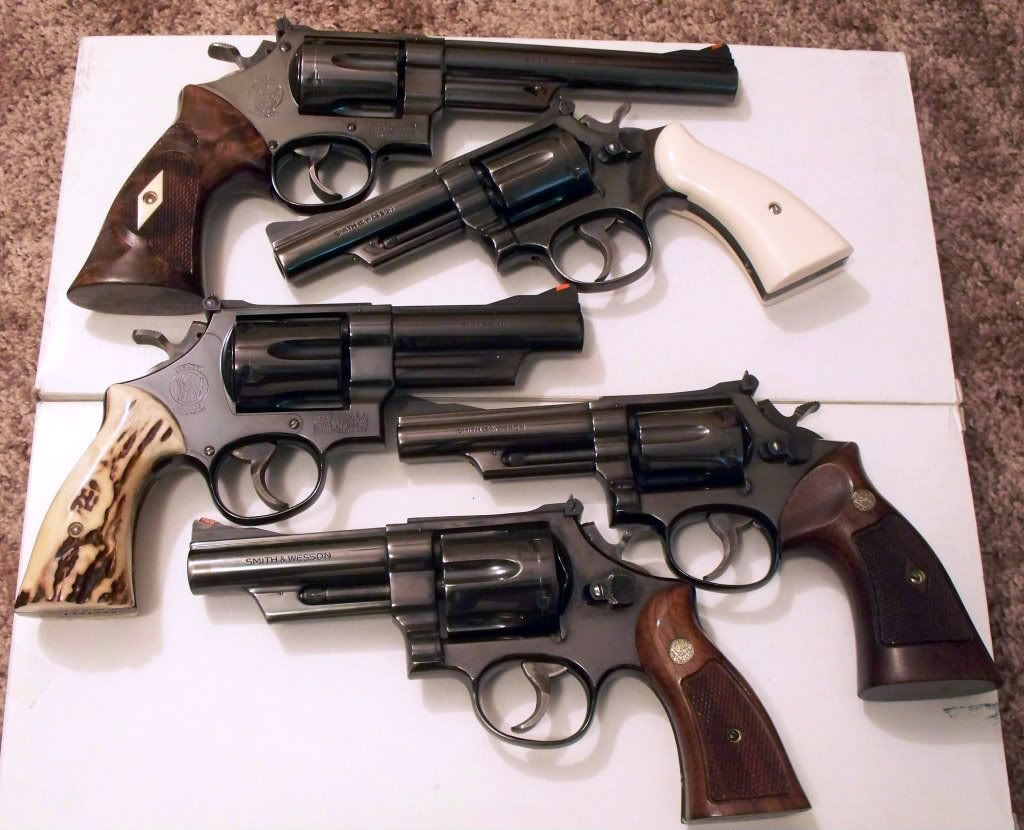With each dash number there was some kind of engineering change. Like when they stop using the top sideplate screw or changed the position of the gas ring.
Actually, the screws in the frame never alone designated any dash changes for S&Ws. The 5th screw you mention, for K and N frames aka the upper side plate screw, was removed by 1956, and so nearly any model marked gun will be a 4 screw, or less. There are a limited number of 5 screw model marked guns floating around, but these are pretty rare. This would have happened because a 5 screw frame was laying around, and S&W didn't waste anything. For the transition from 4 screw to 3 screw, in the early to mid 60s, it was the same thing, that the screw removal alone did not change the dash number.
The dash changes correspond mostly with functionality changes, whereas the amount of frame screws does not impact the function of the gun. I am not sure if the change in position of the gas ring designated a dash number change or not.
Carguychris below explains this in a different way below. He is basically saying that some changes, perhaps many of the changes did not cause a dash change for the gun.
Arguably the most well-known example is the Model 36, which was produced from 1957 until the mid-1980s in no-dash / dash-1 form despite the fact that numerous changes were made during that time, most notably the deletion of the barrel pin in 1982.
One is not necessarily better than the other, but as far as collector value a no dash model will almost always be worth more.
Like others said every time it goes from -1 to -2, to -3 etc. it means there was a design change. Sometimes something as simple as a painted front sight.
There are quite a few examples of later dash guns being more valuable than the predecessors. One shining example is the 29-1, more valuable and much more rare many previous S&W 44 magnums. 27-1s are hard to find as well. For many of the models that got the name change in 1957, the -1 is harder to find. For the -1, S&W decided to reverse the ejector rod threading, and then for many -2 guns, they changed it back.
In addition, a painted front sight never would designate a model dash change since front sights have optional choices. Painting a front sight was also something AFAIK that was never done by the factory. Now of course, a model that is fixed sight, as a model 58, with adjustable sights was then a 57. But as far as the front sight alone, it does not effect the model dash nor would it effect the model IE a model 27 could have a ramp or a patridge.
In my S&W world, named Models are the most desirable
Same thing for my world, but S&W did actually keep the model name for the model number guns. In other words the model 10 was the "model 10 military and police" whereas before 1957, it was the "military and police".
As you can see from the photo the 19 no dash is a four screw which makes it kind of neat
IIRC, aren't all 19 no dash guns 4 screw? Are you just saying its neat because its a 4 screw? I know that for some models, 4 screws are more rare than 3 screws, but I didn't think a 19 no dash could be a 3 screw. A lot of people probably don't know, but out of the 3 4 and 5 screw guns, 4 screw are by far the hardest to find. They are also high quality and can still be had for modest prices, since people are crazy for 5 screw guns.
its hard to generalize...you really need to go model by model....
a. I'd focus on caliber first...
Well, there is also nothing wrong with looking for a model, moreso than a caliber. For example, if you said you wanted a 357, with S&W, there are tons of choices. However, what would I recommend, a model 27 (or variant) of course, followed by a 19 (or variant) probably. Remember, don't pass up a model 23 (for example) just because 38 special doesn't interest you. Many S&W models are hard to find today, and nearly any S&W is firearm with obvious quality emphasis. I recommend an open mind, and because there were so many S&Ws made, a good deal is probably just around the corner.

